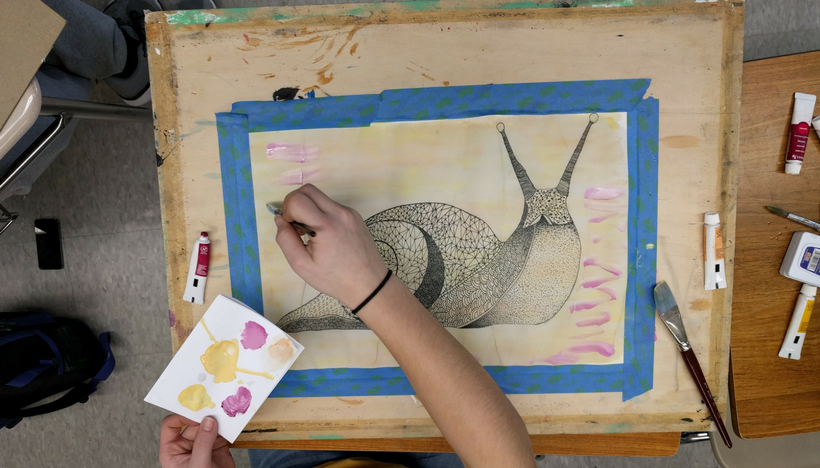This post was written by guest writers Rachel Hoogstraten and Rachel Silverman.
As many great ideas before it, “Artglish”—an integrated arts English course for ninth graders at Mohawk Trail Regional High School in Shelburne Falls, Massachusetts—was born on a school bus. I had agreed to help art teacher, Rachel Silverman, chaperone a field trip to a local museum, and on the way home we got to chatting about our frustrations with teaching. She bemoaned that students often enrolled in her art classes for a mental break during the day and immediately demanded paint brushes, uninterested in engaging in an intellectually grounded practice of art making. I complained that I wanted to offer students creative ways to show their understanding of literature, but that I didn’t have the supplies or the training to effectively teach and assess artistic pursuits. The solution was glaringly obvious: an integrated arts course, which the Kennedy Center’s Arts Edge defines as, “An approach to teaching in which . . . students engage in a creative process which connects an art form to another subject area and meets evolving objectives in both.”
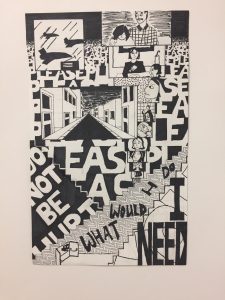
We were lucky to have a supportive administration, but the task was still daunting. A financially strapped, rural school district and very small student body left us with some particularly sticky logistical challenges. We knew the school couldn’t afford to have us co-teach the class—financially or in terms of personnel—and that students are often locked into schedules by limited offerings. Rachel was the only art teacher for the middle and high school, and I taught the entire ninth grade as well as two upper-class electives. What we ended up launching the following fall was a “linked curriculum” course. Students were scheduled for an English course one block and an art course another, and we did our best to coordinate.
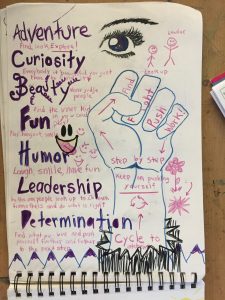
Despite the challenges—Rachel and I have never shared a prep period, for example, and do most of our joint planning on our own time—“Artglish,” as our first batch of students quickly dubbed it, was and remains exciting for everyone involved. Rachel and I have found energy and pedagogical challenge in designing a linked curriculum. We agree that working together has made us both more cognizant of what we do and why and forced us to examine our own teaching practices with honesty and flexibility. The students engage much more deeply with our topics since they spend twice as much time with them, and the interdisciplinary approach helps them locate their school work in their real lives outside the school. Even our administrators have embraced the course, publicizing it to the community and encouraging more faculty to collaborate. This year, at the suggestion of faculty, they hired an arts-integration specialist who is now working with the whole middle school team to increase the use of arts in all academic subjects.
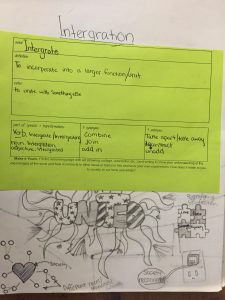
As I write this, another semester of Artglish is drawing to a close, and my classroom is full of students working on their integration final projects. First they chose a guiding concept word, researched an artist and an author whose work relates to the word, and are now designing an original piece of art which they will accompany with a reflective artist statement. The course wraps up with a group presentation and critique of their projects. It may be exhausting, but seeing true student engagement and feeling connected to my own practice are absolutely worth all the glitter I have to clean up.
Note: Cover artwork by student Ashley LaCross.
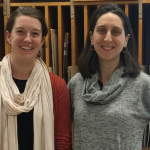 Rachel Hoogstraten began her career with a BA in creative writing from Emerson College before turning to teaching and receiving her M.Ed. from UMass Amherst. She has been teaching high school in Western MA for seven years and is always looking for creative ways to transform the English classroom.
Rachel Hoogstraten began her career with a BA in creative writing from Emerson College before turning to teaching and receiving her M.Ed. from UMass Amherst. She has been teaching high school in Western MA for seven years and is always looking for creative ways to transform the English classroom.
Rachel Silverman holds a BA in studio art from Mt. Holyoke College and a MA in art education from the University of Florida, where she conducted research on teacher-led art integration initiatives. Rachel has taught K–12 visual art for 10 years and loves the transformative power of art in the classroom. She looks forward to supporting and creating more interdisciplinary collaboration amongst her colleagues.

